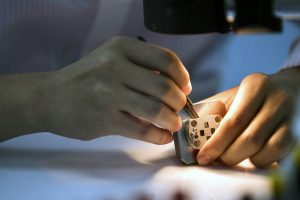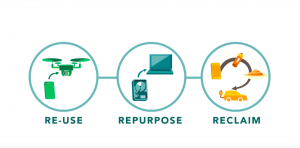
Reverse supply chain management
By Linda Li, executive director and chief strategy officer at Li Tong Group
Electronics Regulations & Standards Engineering Supply Chain Logistics Logistics management management recycle recycling Reverse Reverse supply Chain supply chainAn environmentally & commercially sustaining practice
Today’s accelerated pace of innovation in the enterprise and the consumer domains is resulting in an unprecedented proliferation of technological devices. Concurrently, there is also a shrinking inventory of the raw materials required to make them. This bottleneck of raw materials is becoming a crisis on a global scale and represents the requirement for manufacturers to innovate their logistics and supply chain processes.

A comprehensive, closed-loop recycling approach reduces the demands for raw materials used to make electronic components.
Traditionally, electronics and high-tech manufacturers have used conventional recycling methods as a means to dispose of end-of-life technology. These methods are called cradle-to-grave or down-cycling where the process degrades the quality of materials over time, eventually resulting in waste. This process, while effective for returning technology to its raw material state, is environmentally taxing and can be a burden on a company’s bottom line.
A comprehensive, closed-loop recycling approach reduces the demands for raw materials to produce a new product by using cradle-to-cradle or reusable materials harvested from end-of-life assets/surplus inventory and strategically introducing them into the forward supply chain.
How the Tech Industry is Adapting
OEMs are releasing new products at a faster rate than any other time in history and older models are subsequently reaching the end of their life quicker. On average, between five and seven percent of the typical OEMs’ annual shipment volume becomes obsolete before it is sold or reaches the consumer.
Recycling and re-use have become strategic decisions at the earliest stage of product development and at the highest levels of the corporate organization. Through RSCM, OEM’s can harvest parts and components from these obsolete assets and excess inventory and inject them into the manufacturing networks of new products—eliminating waste reducing manufacturing costs.
The strength of an effective and profitable RSCM program lies in the depth of its engineering expertise. Engineers must consider the aftermarket value for devices, the primary market value for component parts such as screens, switches, and chips, as well as the recycling value of metals, and extract the usable elements for repurpose through a partner network. Remaining non-usable parts are disposed of via highly regulated, compliant systems.
Reverse Logistics in a Device-Driven World
Because devices are so highly integrated — not your traditional PC or laptop — they are very small and difficult, if not impossible, to take apart. If the device is broken or defective, the whole thing has to be taken back.
On average, the typical lifespan of a mobile device can vary between three to five years. Consumers, however, choose to change or upgrade their products after using them for a year and a half, even if the devices are still highly functional. This has led to a significant increase in product trade-ins and aftermarket/third party refurbishing businesses.
When it comes to properly managing a reverse supply chain or reverse logistic service for devices, it’s important to note that most device manufacturers are smaller OEMs, perhaps even start-ups, and it’s costly for manufacturers of this size to design and deploy their own RSCM programs. It is neither economical nor efficient for small OEMs to build their own reverse logistic network. It is strongly suggested that smaller OEMs partner with established RSCM providers and leverage their knowledge, experience and existing omni-channel take back platforms.
A good RSCM partnership will allow the device OEM to focus on what they do best — designing innovative products and getting them out the door — while also delivering a return service that their customers demand and fulfilling compliance obligations.
The Circular Economy
There are limited processes for OEMs, historically speaking, when it comes to dealing with post-consumer and industrial recycling of electronic devices; none of them are environmentally sustaining, including selling to less developed markets to recover value and minimize e-waste and recycling to recover raw materials where possible. 
Closed-loop RSCM reduces the carbon footprint of manufacturing through the recovery, reuse and remanufacturing (3R) of end-of-life technology and its components. The 3R approach can reconcile consumer demand and the shrinking inventory of materials needed to meet it by linking reverse supply chains with forward supply networks. Transferable components can be re-programmed so that they can have a second life in alternative applications. Remanufactured parts can either go back into the OEM’s original forward logistics supply chain or it can be sold or remarketed in another market.
The key to the popularity of these programs among consumers is that they give credit for old devices that can be applied to new ones. If an OEM offers an incentivized program, owners of mobile phones that are about to become obsolete can trade their phone in for credit toward the new model. In fact, the volume is 10 to 20 times higher than that experienced by programs that do not offer an incentive.
These programs benefit the OEM in several significant ways. First, it helps focus the consumer’s attention on devices offered by that particular manufacturer, rather than competitors. If a consumer can apply the value of the phone he’s using today toward the phone he wants to use tomorrow, he is far less likely to check out what other vendors are offerings. Second, an incentivized take-back program serves as a great way to prevent second-hand devices from being sold into the emerging markets that are strategically important for the OEM. Skillfully executed take-back programs help keep devices out of the unofficial channels that often cannibalize new products and markets.
The world’s leading technology brands win business by providing their customers with a brand experience that extends beyond hardware, UX and support, and also extends to what happens once the product needs to be replaced and recycled. Well-planned RSCM programs provide confidence to the brands and the consumer the product will be taken care of in the most responsible way possible and valuable components will not simply be destroyed or sent to landfill, but re-used in a progressive and intelligent way.
Strong RSCM programs enable all companies to deepen their customer relationships, strengthen their organizational and culture initiatives, maintain the highest levels of compliance and turn a profit. It’s a win-win for the brand, the customer and the environment.
Eliminating Parts Shortages
As with the tragic tsunami that hit Thailand in 2004, there can be drastic disruptions to the global supply chain. In the case of the Thailand disaster, the entire global supply of hard drives was disrupted for several months. Supply chain disruptions are very costly to an OEM, and even an entire market.
Imagine if OEMs instead had programs in place for harvesting components from older generations of devices. With a process where the device is properly de-manufactured, harvested components — such as hard drives — can be reused and repurposed as a back-up supply for repairs and other uses, providing a level of protection against the fluctuation of global markets.
This strategy could turn reverse logistics or reverse supply chain into a profit center; it represents real money savings. The parts harvested from older-generation devices have already been paid for, and don’t need to be paid for again. Simply pay for the service to harvest them out of the device. If a company were to smelt the entire motherboard from an older-generation product, there would be little to no financial recovery, depending on the precious metal commodities market. But if an SSD is harvested and reused, for example, that’s a gain of about $20 U.S.
Finding the Right RSCM Partner
Enabling standardized service in the U.S. and markets around the globe is critical for OEMs. They need to ensure the products moving through the reverse supply chain are handled and treated according to the same standards, while also complying with local laws and regulations. One of the best ways to achieve both goals is to engage with an RSCM service provider that has global coverage and facilities that maintain the same service standard for quality, security and compliance to the extent that both platform development and management capability are as strong as its technical processing capability worldwide.
The cradle-to-cradle concept is an approach to designing products with the entire lifecycle in mind. Leadership and engineering expertise are required to enable the technology community to capitalize on cradle-to-cradle manufacturing and support economic development and environmental sustainability. Engineering teams must consider the aftermarket value for devices, the primary market value for component parts and extract the usable elements for re-sale to a global partner exchange.
Taking care of the logistical, compliance and industrial issues of deploying technology take-back initiatives can be a considerable barrier for brands seeking to do better. Leaders in Reverse Supply Chain Management (RSCM) today are providing technology brands with much-needed solutions to complex issues, and are also helping them turn cost centers into profit centers by dismantling obsolete technologies and re-purposing valuable components into new devices.

Linda Li, executive director and chief strategy officer at Li Tong Group
Tech companies need to seek out an RSCM partner that understands the importance of technology developed for closed-loop systems as companies begin to rethink design and begin integrating repurposed or re-usable components. Not only is it good for the environment, but also it can drive economic growth by demonstrating manufacturers’ commitment to long-term sustainability efforts. With Cradle-to-Cradle manufacturing in mind, companies can develop products that can be fully recycled into materials they can use for products in the future.
